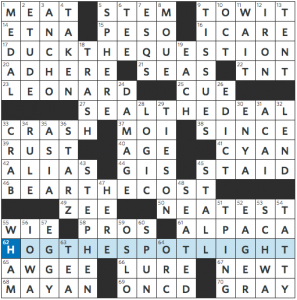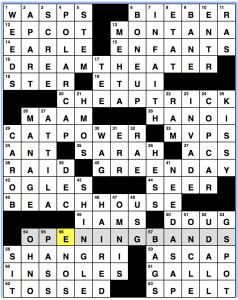Andrew Kingsley’s New York Times crossword—Jenni’s write-up
What I didn’t know before I did this puzzle: pretty much everything mentioned in the theme answers. An original theme and a very straightforward puzzle that played a little bit easy for a Wednesday, perhaps because the theme answers are not inferable without crossings.
1a tells us we’re in for something a little different: 1a [With 27-, 49- and 66-Across, phrase applicable to five innovations in this puzzle (as suggested by the starred clues)] So we have five theme answers in addition to the four entries mentioned in 1a. That’s a lot of theme material for a daily puzzle.
The theme answers are all new ideas or inventions, as promised:

NYT 8/8, solution grid
- 18a [*Thomas Edison and Joseph Swan] invented the LIGHT BULB. I did not know that Joseph Swan patented a light bulb ten years before Edison. Swan subsequently sued Edison for patent infringement and won; part of the judgment was that Edison had to make Swan a partner in his company.
- 23a [*Gottfried Wilhelm Leibniz and Isaac Newton], working separately, discovered CALCULUS. According to Wikipedia, their methodology was quite different. I actually did know this, vaguely.
- 33a [*Dmitri Ivanovich Mendeleev and Julius Lothar Meyer] independently published versions of the PERIODIC TABLE. I didn’t know about Meyer. I also didn’t know that they both studied in Heidelberg under Robert Bunsen, inventor of the eponymous burner.
- 50a [*Leo Szilard and Joseph Rotblat] were both part of the Manhattan Project and developers of the ATOM BOMB. Rotblat reportedly argued against continuing work on the bomb after the defeat of Germany.
- 54a [*Alexander Graham Bell and Elisha Gray] simultaneously developed the TELEPHONE. They filed initial patent applications on the same day.
The phrase described in 1a turns out to be GREAT MINDS THINK ALIKE. I figured that out as soon as I got MINDS at 27a. It would have been more fun if those four words had been clued without reference to the theme until 66a, ALIKE. It would have made the puzzle a smidgen easier, but still Wednesdayish. I still liked the puzzle. The fill is remarkably decent given the absurd amount of theme material
I suppose it’s not surprising that all but one of these stories involves a dispute or controversy over who should get credit. The exception is the Manhattan Project.
That’s the most research I have ever done for a blog post, and I know I only scratched the surface. Feel free to elaborate on any of those stories in the comments. And that’s it for tonight!
Samuel A. Donaldson’s Wall Street Journal crossword, “Animal Hijinks” — Jim’s review
Theme: Animal homonyms in the following form: “animal THE x.”

WSJ- Wed, 8.8.18 – “Animal Hijinks” by Samuel A. Donaldson
- 17a [Give an evasive answer] DUCK THE QUESTION
- 27a [Sign a contract, say] SEAL THE DEAL
- 46a [Cover expenses] BEAR THE COST
- 62a [Monopolize attention] HOG THE SPOTLIGHT
I’ll be honest, this seems like a Monday-level theme, and if it was running then, I probably wouldn’t have a problem with it.
But by Wednesday I would hope to see something with more interesting wordplay than phrases whose first word is a homonym of an animal. This feels like a well-worn trope in crosswords, and I expected to see numerous iterations of it in the cruciverb database.
But I didn’t. I only found one case from the New York Sun in 2006 where the phrases had this exact form. The two puzzles share BEAR THE COST and SEAL THE DEAL but the older one also had BADGER THE WITNESS (nice, but 16 letters long) and WHALE THE TAR OUT OF (ick!).
So really, since this theme hasn’t appeared in any major publication (as far as I can tell from looking at cruciverb) and since the two grid-spanners appear to be cruciverb.com debuts, I have to look at this in a new light. It’s solid, clean, and evocative. In other words, nice! (But I can still wish it ran on an earlier day.)
It’s curious that there aren’t any fill entries longer than seven letters. Demands by the theme don’t seem exorbitant, so I wonder if there’s a different grid structure that could’ve allowed for some shinier fill. On the other hand, the less-constrained shorter fill might have been more fitting for a Monday puzzle.
 Still, there are a couple bits of crosswordese that triggered the grumble-meter: plural ESQS and MOUE which I’ve only ever seen in crosswords. And I wonder if the STARZ / ZEE crossing gave anyone any trouble. The first is clued [“Power” network] and the latter [Don Diego de la Vega’s trademark]. If you didn’t recognize the TV show, as I didn’t, nor make the connection to Zorro (which I thankfully did), you might have been Naticked there.
Still, there are a couple bits of crosswordese that triggered the grumble-meter: plural ESQS and MOUE which I’ve only ever seen in crosswords. And I wonder if the STARZ / ZEE crossing gave anyone any trouble. The first is clued [“Power” network] and the latter [Don Diego de la Vega’s trademark]. If you didn’t recognize the TV show, as I didn’t, nor make the connection to Zorro (which I thankfully did), you might have been Naticked there.
My learning moment: Did not know ANCHO [Trendy chili]. Per Wikipedia, it’s a dried poblano pepper. Usually mild, it can unpredictably produce significant heat.
My d’oh! moment: I only just now got the clue for STEPHEN: [King with a macabre bent]. I was thinking all along there was some King Stephen I didn’t know about who enjoyed torture. No, it’s author STEPHEN King (who may or may not enjoy torture).
That’s all I’ve got. Not the most exciting of themes, but it might be a good one to hand to someone branching out from early week grids.
Brendan Emmett Quigley’s AVCX, “Acts First” — Ben’s Review
 It’s BEQ week at the AVCX, so let’s get down to business and
It’s BEQ week at the AVCX, so let’s get down to business and defeat the huns solve the puzzle.
“Acts First” is a little clunky as far as titles go for this sort of thing, but it does encapsulate what’s happening in each theme entry:
- 16A: Act for which both words can precede the word TICKET — DREAM THEATER
- 20A: Act for which both words can precede the word SHOT– CHEAP TRICK
- 29A: Act for which both words
can precede the word NAP — CAT POWER - 40A: Act for which both words can precede the word ROOM — GREEN DAY
- 45A: Act for which both words can precede the word PARTY — BEACH HOUSE
- 54A: What 16A, 20A, 29A, 40A, and 45A are, in this puzzle — OPENING BANDS
It’s a cute theme, and if you’re musically-minded like I am, this one fell pretty easily.
Please come hang out with me in the latest BEACH HOUSE album, it’s lovely, as is all their work.
The rest of the fill here was fine. Question for you: what’s the worst opening band you’ve ever seen? For me it was some local act that opened for The Noisettes back in 2009 – it was a promo show (and free!), but the opener had no connection to the retro-tinged stuff that the group we were there to see specialized in.
4/5 stars.
Bruce Venzke & Gail Grabowski’s LA Times crossword – Gareth’s summary

LA Times
180808
This is a version of an infrequently seen theme type. A notable example was by I think Peter Gordon, and featured A MAN walking down stairs. Today it’s a RUNNINGGAG with GAG running from left to right as the theme answers move downwards. GAGARINCUP is a fairly obscure answer, which the clue acknowledges by giving us a push with [astronaut]. However, it’s an interesting answer, with the KHL being a Western Hemisphere rival to the NHL. Difficult answers in moderation enhance a puzzle in my book.
Favourite entries: IWOJIMA, COATI. Least: silly abbr. STAC crossing PARC.
Gareth
I liked the misdirect clues in the NW corner for 14A and 2 & 3D; they weren’t stumpers by any stretch, but I went in a different direction for all three. Clever.
NYT Wednesday record (4:27) for me! Definitely played easy for a Wednesday; the only invention I didn’t know from the inventors’ names was atom bomb, but I had B_MB at the tail so it was very inferrable. I think the puzzle would’ve been fine with harder fill even if the theme answers are “not inferrable” — I think most of these things are common knowledge enough at least to be ran on a Wednesday.
I think Jim’s being kind to the WSJ theme. Two of the four verbs are derived from the animal (HOG and DUCK) while two are unrelated etymologically (SEAL and BEAR). Are “to hog” and “hog” homonyms, or just two uses of the same word? I guess you never know what will bug a solver, but this bugged me. (Hey, another themer.)
I thought the WSJ theme was disappointing, too. And I either guessed the crossing of the golfer and pop duo or unconsciously remembered the first from crosswordese. OTOH, interesting to learn that ETNA has not just hot lava but cold skiing.
Happy to see your weird avatar, Martin. (What the heck is that?) I hope you stick around.
I’ve said it before, I don’t parse these puzzles as much as some. To me, the themers were all simply animal references. Does the title, “Animal Hijinks” have some hidden meaning?
Sushi fixins.
Oh, yeah. I have never sampled sushi.
A very easy puzzle that was of Monday difficulty. The only positive was that some of the inventors were not well known. This might be a good format for educational purposes but does not make a particularly interesting puzzle per se..
Something similar to today’s WSJ theme appeared in a major publication earlier this year:
https://www.xwordinfo.com/Crossword?date=3/21/2018
Ha! Yes. That was a fun one. How quickly we forget. (And by “we” I mean “I.”)
Interesting choice to use the word “discover” with respect to CALCULUS. There are differing philosophical camps regarding whether mathematics is created or discovered—I’m always curious where people’s intuition leads them on that dichotomy.
I’m in the discovered camp. Now it may take some seriously creative thinking to discover it, but the math is there.
I have mixed intuitions about it. Like, if we were to ever meet aliens, I’m pretty confident they’d have a concept of pi, and probably also e. And likely something akin to calculus and graph theory.
But then when you get down to the more abstract, more esoteric math, I’m not so sure. Would any intelligent species eventually develop a version of category theory, or schemes, or homology and cohomology? Would they even rely upon the same system of logic that underpins most of mathematics?